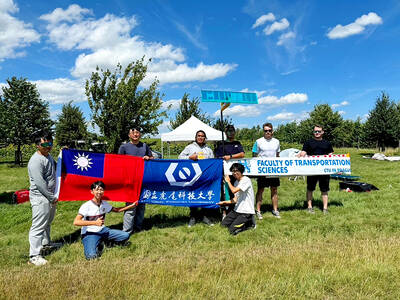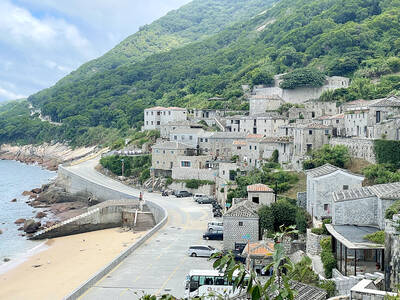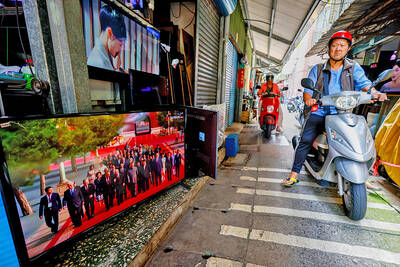While infrared therapy has become a popular treatment for aches and pains, a doctor cautioned that it is not a cure-all and people with certain health conditions are advised to avoid using such devices.
Infrared therapy can generally be subdivided into near and far-infrared therapies, with the former often used in the earlier stage of treatment, said Chen Kuan-cheng (陳冠誠), a doctor at National Taiwan University’s Department of Rehabilitation Medicine.
Near-infrared therapy has greater penetration and can warm up the target area more efficiently, increasing the blood flow and raising the metabolic rate, he said.
Far-infrared therapy, which has become more common, does not heat up the body, but increases the body’s capability to absorb protein, dilates blood vessels and reduces inflammation, he said.
Infrared therapies are usually used to treat sports injuries, arthritis, damaged soft tissue or taut muscles, he added.
However, people should be careful to observe the proper time, distance and intensity when using infrared beams, making sure to avoid direct exposure to the eyes or open wounds, he said.
Every session should last no longer than 15 to 30 minutes, with at least one hour of rest between sessions, he said, adding that users should keep the device about 40cm to 60cm away from the skin.
The intensity of the beams should be adjusted according to instructions in the equipment’s manual, he said.
Users should ensure that they stay in a room that is not overtly hot, he said.
People with diabetes, poor circulation or cognitive deficiency should not use such devices as they could inadvertently suffer burns, while those with malignant tumors should avoid them as they could cause tumor cells to spread, he said.
People who have acute inflammation, dermatitis and eczema should also avoid infrared therapy as it could cause their condition to worsen, he added.
Separately, the Food and Drug Administration reminded people to only buy devices that carry the Ministry of Health and Welfare’s medical license number.
Users should try to hydrate themselves adequately during each therapy session, and ensure that the target area is clean and free of medication for better results, it said.

The Chinese military has built landing bridge ships designed to expand its amphibious options for a potential assault on Taiwan, but their combat effectiveness is limited due to their high vulnerability, a defense expert said in an analysis published on Monday. Shen Ming-shih (沈明室), a research fellow at the Institute for National Defense and Security Research, said that the deployment of such vessels as part of the Chinese People’s Liberation Army (PLA) Navy’s East Sea Fleet signals a strong focus on Taiwan. However, the ships are highly vulnerable to precision strikes, which means they could be destroyed before they achieve their intended

The Taiwan Experience Education Program (TEEP) has funded short-term internships in Taiwan for more than 4,500 young people from more than 40 countries since 2015, with the goal of attracting and retaining international talent, the Ministry of Education said yesterday. Fifty-five colleges launched 514 projects this year, including in fields such as semiconductors, artificial intelligence, medicine and biotechnology, green energy, and sustainability, it said. The program provides research and practical internships in Taiwan for two to six months, and offers cultural exchange and networking opportunities, the ministry said. For example, National Formosa University’s Embedded System and Autopilot Laboratory developed two solar-powered drones in

GLOBAL: Although Matsu has limited capacity for large numbers of domestic tourists, it would be a great high-end destination for international travelers, an official said Lienchiang County’s (Matsu) unique landscape and Cold War history give it great potential to be marketed as a destination for international travelers, Tourism Administration Director General Chen Yu-hsiu (陳玉秀) said at the weekend. Tourism officials traveled to the outlying island for the Matsu Biennial, an art festival that started on Friday to celebrate Matsu’s culture, history and landscape. Travelers to Matsu, which lies about 190km northwest of Taipei, must fly or take the state-run New Taima passenger ship. However, flights are often canceled during fog season from April to June. Chen spoke about her vision to promote Matsu as a tourist attraction in

Taipei resident Mu Chu-hua caught some glimpses of China’s mighty military parade on YouTube on Wednesday. As she watched hypersonic missiles roll down Beijing’s Changan Avenue and troops march in lockstep, she did not feel like they posed a threat to Taiwan. Mu, a 69-year-old retiree, said she saw the parade as simply a way for Chinese President Xi Jinping (習近平) to “say thank you to the troops.” “I thought it was quite normal,” she said. “It was very cool.” China’s military parade commemorating the end of World War II was being watched internationally for insights into Beijing’s military advances and its show